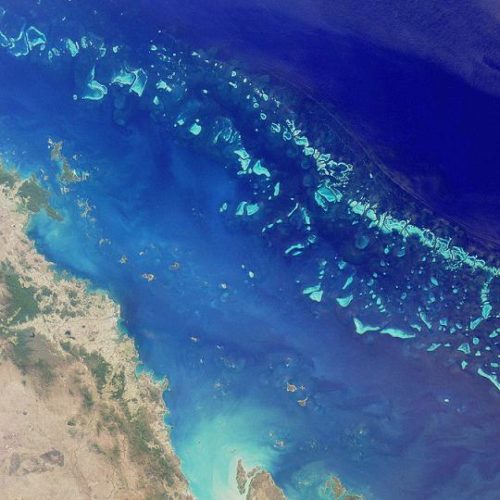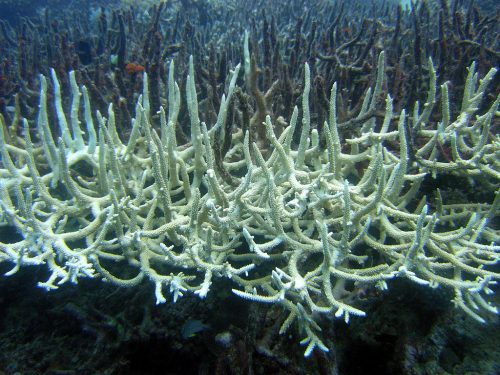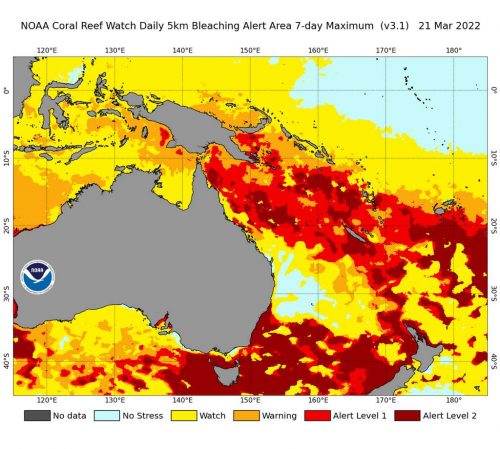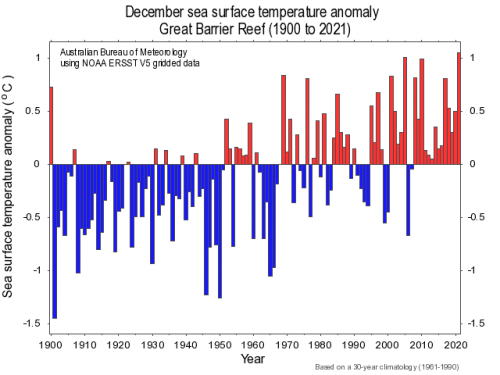Great Barrier Reef, Australia —(Map)
The group in charge of caring for Australia’s Great Barrier Reef (GBR) reports that the reef appears to be going through another widespread coral “bleaching” event. Once again, rising ocean temperatures are threatening this massive underwater treasure.
The Great Barrier Reef in the Pacific Ocean is the largest coral reef in the world. It runs for over 1,400 miles (2,300 kilometers) off the northeast coast of Australia. The reef is home to thousands of different forms of underwater life.

(Source: NASA, by MISR [Public domain], via Wikimedia Commons.)
As the temperature of the world’s oceans has increased because of human-caused climate change, corals around the world have begun to die off. This is often called “coral bleaching” because sometimes the dying corals turn white.
Why Coral Reefs Matter
The coral shapes we’re used to seeing are built over a very long time by millions and millions of tiny coral animals. The large coral structures provide conditions that attract and support many other sea creatures.
When corals die off, it’s not just about the corals. It’s also about the collection of creatures that live in and around them. The richness of all these different kinds of animals in the same place is very important to the health of oceans.

(Source: Matt Kieffer [CC BY-SA 2.0], via Wikimedia Commons.)
The first widespread, serious bleaching event – known as a “mass bleaching event” – hit the GBR in 1998. Since then, there have been several other mass bleaching events, in 2002, 2016, 2017, and 2020.
Depending on how serious the bleaching is, it’s possible for some damaged coral reefs to recover. But even when coral reefs survive bleaching events, they are left much less healthy because of the stress of the event.
It’s still too early to know if this is a mass bleaching event. So far, only about half of the reef has been studied from the air. A 10-day study by scientists from the United Nations started on Monday.

(Source: NOAA Coral Reef Watch.)
But scientists say a mass bleaching event is likely. The Great Barrier Reef Marine Park Authority said on Friday that the reef is showing signs of serious bleaching in places. The group reports widespread bleaching in the far north of the reef. In the central part of the reef, the bleaching appears to be severe.
Dr. Britta Schaffelke at the Australian Institute of Marine Science told the Guardian, “At the moment, what we see is widespread and in some parts it is severe, and that is worrying. There is no doubt about it.”
Scientists are especially concerned that this event is happening during a “La Niña” year. In La Niña years, there are more clouds and rain on Australia’s east coast, and water temperatures are usually cooler. But last December (which is summer in Australia) brought record temperatures to GBR’s waters. If this is a mass bleaching event, it will be the first time one has ever happened during a La Niña year.

(Source: [CC BY 3.0 AU], Australian Bureau of Meteorology.)
In January, Australia’s government announced a $1 billion (about US $746,700,000) plan to protect the GBR. But groups working to protect the environment have criticized the plan. One problem is that the money is spread out over nine years.
But the biggest complaint about the plan is that it doesn’t focus on climate change. The greatest threat to the reef comes from global warming, which is driven largely by emissions from fossil fuels. Environmental groups say that the best thing Australia could do to help the GBR is to cut its pollution sharply.
😕
This image has not been loaded because of your cookie choices. To view the content, you can accept 'Non-necessary' cookies.
In January, Australia’s government announced a $1 billion (about US $746,700,000) plan to protect the GBR. The plan has been criticized because it doesn’t focus on the greatest threat to the GBR, climate change. Above, coral bleaching in the GBR in early March, 2022.
😕
This map has not been loaded because of your cookie choices. To view the content, you can accept 'Non-necessary' cookies.
